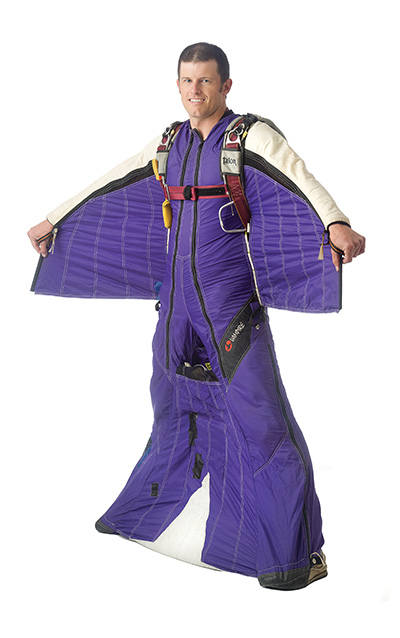
As far as Chris McNamara knows, he has not sustained any injury to his amygdala, the portion of the brain thought to process fear. Never mind that as a pioneering BASE jumper (the acronym stands for buildings, antennae, span, earth) he has literally stepped off the edge of a 3,000-foot cliff, wearing nothing more than a nylon “squirrel suit” secured with duct tape. In his 32 years, McNamara has climbed El Capitan over 70 times and did the first girdle traverse of that cliff at age 20 in 1998; he also holds nine big wall speed-climbing records. Encouraged by his wordsmith father Steve, former publisher of the Pacific Sun, McNamara has chronicled his adventures on his website and published 15 climbing guidebooks. Engaged to be married to his longtime sweetheart, McNamara has retired the jumpsuit and turned to the ocean, shredding his stand-up paddleboard through waves around the world. “I might even try big wave surfing,” he says. “At least it has a much better survival rate.”
Favorite Marin adventure as a kid?
As a freshman in high school I climbed the north tower of the Golden Gate Bridge with friends. We took photos and passed them around school. My parents found out when another parent asked them, “How could you let your son climb the Golden Gate Bridge!?”
When did you start rock climbing, and where?
In eighth grade, a friend had a birthday party at the old Class 5 Fitness in San Rafael. Six months later I met Mark Melvin, a longtime Marin resident, who was starting Touchstone climbing gyms. I took all my snack bar/umpire/grounds-keeping money from Mill Valley Little League work and invested in Touchstone (I was 15). Mark then decided to take me up El Capitan and after that I pretty much dedicated my life to climbing El Capitan for a decade.
As the founder of the Safe Climbing Association, what would you say are the top three safety rules for BASE jumping?
The main rule for BASE jumping is don’t jump if it doesn’t feel right. It’s a sport that kills a lot of people, so if it doesn’t really feel worth it, go back and jump another day. Or not at all. When I found myself standing at the exit point wondering if it was worth it, then I sensed it was time to quit. I had this rule: “If you face a big question and the answer is not “Yes!!!!” then the answer is no.
What would you eat before a jump?
I usually ate candy bars. I did most of my big walls on Butterfingers but for BASE jumping I switched to Snickers. They seem a little healthier.
What would you do to prepare for a jump?
When evaluating a jump, fear is your friend. It knocks some sense into you. However, once you have committed to jump, fear just makes you tense and you become only half yourself. I’ve stood at an exit where I’d decided to jump but my head was not straight. Sometimes in those cases I said, “Ah, f’ it.” Not because I really meant it. But it cleared my head and let me relax.
When did you start BASE jumping?
2005. I didn’t set out to jump. But my girlfriend did, and one night I went along and climbed a 500-foot power tower in the Central Valley. Back then it was just too easy not to. I didn’t even have skydives (under my belt), which is of course how you should start. Standing at the exit point I half hoped we could both just back off—it was pitch black and the entire tower was buzzing with electricity. When it was my turn I thought everything is worth doing once. And it was. While physical time is finite, mental time is quite elastic. Those two seconds before my canopy opened went on forever.
What made you consider retiring?
BASE takes you way past ordinary life to one of endless unknown and possibility. It’s no surprise that something that good comes at a cost. Of the roughly 150 or so jumpers I’ve met, 15–plus are dead now. There is no escaping the brutal fact that if you meet a lot of BASE jumpers, in a few years a shocking number will no longer be around.
Eventually the combination of friends dying and the fact the sport was no longer that exciting made me realize it was time to quit. I had one big last jump … it was quite “grand” and the perfect jump to end on.
What will you do with your flying suit?
My first one I’ll keep forever. It has so many stories. So many people thought I wouldn’t make it and somehow that thing kept me alive. All the rest of my gear I sold on eBay. I have one skydiving parachute. Anyone out there who is interested can e-mail me.
What did your parents say when they saw your first BASE-jumping video?
They were terrified. They spent so much time being concerned about my climbing El Capitan and going on climbing trips to Baffin Island or Alaska. When I slowed down on climbing they thought, “Made it through that. Phew!” Then I choose to take up a sport that makes climbing look harmless. So they were not happy about BASE jumping.
What is your favorite drink and where do you like to drink it?
A beer at Mill Valley Beerworks is pretty great. But the best place to have a beer is right after a big day of climbing, jumping or surfing, usually in a really remote spot with good friends, like the summit of El Capitan or the coast of Baja.
This article originally appeared in Marin Magazine’s print edition under the headline: “Base Jumping Adventures“

Mimi Towle has been the editor of Marin Magazine for over a decade. She lived with her family in Sycamore Park and Strawberry and thoroughly enjoyed raising two daughters in the mayhem of Marin’s youth sports; soccer, swim, volleyball, ballet, hip hop, gymnastics and many many hours spent at Miwok Stables. Her community involvements include volunteering at her daughter’s schools, coaching soccer and volleyball (glorified snack mom), being on the board of both Richardson Bay Audubon Center. Currently residing on a floating home in Sausalito, she enjoys all water activity, including learning how to steer a 6-person canoe for the Tamalpais Outrigger Canoe Club. Born and raised in Hawaii, her fondness for the islands has on occasion made its way into the pages of the magazine.


